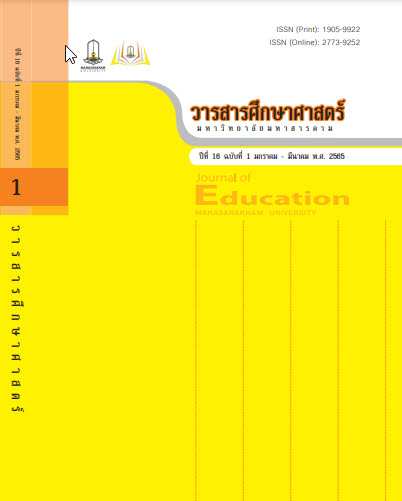The Instruction of Folk Music Major (Mor Lam): A Case Study of College of Music, Mahasarakham University
Main Article Content
Abstract
The article titled “The Instruction of Mor Lam Performing Arts: A Case Study of College of Music, Mahasarakham University” aims to investigate the program and instructional pattern and practice of the Mor Lam Performing Arts Program at College of Music, Mahasarakham University. The study employs the qualitative research methodology based on a documentary study, observation and interviews. The key informants comprise 3 lecturers, a folk music expert, an associate dean for academic affairs, a program chair and 4 students in the program. The findings reveal the following:
The Mor Lam Performing Arts Program at College of Music, Mahasarakham University, is the first of its kind to offer a Bachelor’s program in this specific field. The program structure follows the model issued by the university and the Office of the Higher Education Commission and features practicum courses in every semester on top of theoretical and practical courses related to Isan music, western music and Thai classical music.
Two instructional patterns are implemented: group instruction and one-on-one instruction. Group instruction is conducted based on the students’ class levels and the contents specified in the lessons. The lecturer of each class gives a lyric to the students in advance to memorize. In class, the lecturer sings the whole lyric once to the students before teaching them to sing it a line at a time, going back and forth to review the lesson at intervals. Then students are given time to practice on their own. Before the class is dismissed, the lecturer and the students sing the entire piece together and record the singing so that the students can take it home for further practices. One-on-one instruction is conducted based on the students’ individual appointments with the lecturer to adjust their singing techniques, correct their mistakes and receive advice on appropriate approaches from the lecturer. To give the students’ scores, the lecturer observes their learning behavior and development in class.
In addition, midterm and final assessments of the students are conducted by holding performances for a panel of committee, a real audience and external experts. The results of the research found that the students were able to apply the advice from the judges to make improvements for good performances.
Downloads
Article Details

This work is licensed under a Creative Commons Attribution-NonCommercial-NoDerivatives 4.0 International License.
References
คุณากร พันเทศ. (2563). นิสิตสาขาหมอลำวิทยาลัยดุริยางคศิลป์ มหาวิทยาลัยมหาสารคาม. สัมภาษณ์
เจริญชัย ชนไพโรจน์. (2563). ผู้เชี่ยวชาญประจำวิทยาลัยดุริยางคศิลป์ มหาวิทยาลัยมหาสารคาม. สัมภาษณ์
ชุมเดช เดชพิมล. (2563). อาจารย์ประจำวิทยาลัยดุริยางคศิลป์ มหาวิทยาลัยมหาสารคาม. สัมภาษณ์
ณรุทธ์ สุทธจิตต์. (2021). ว่าด้วยดนตรีศึกษาและระบบการศึกษาไทย. สืบค้นวันที่ 18 พฤษภาคม 2564 จากเวปไซต์ http://kotavaree.com/?p=215
พิภัช สอนใย. (2563). หัวหน้าหลักสูตรปริญญาตรี วิทยาลัยดุริยางคศิลป์ มหาวิทยาลัยมหาสารคาม. สัมภาษณ์
ภัทรกร กาเผือก. (2563). นิสิตสาขาหมอลำวิทยาลัยดุริยางคศิลป์ มหาวิทยาลัยมหาสารคาม. สัมภาษณ์
มัลลิกา ชายทวีป. (2563). นิสิตสาขาหมอลำวิทยาลัยดุริยางคศิลป์ มหาวิทยาลัยมหาสารคาม. สัมภาษณ์
รัตนา สารศรี. (2563). อาจารย์ประจำวิทยาลัยดุริยางคศิลป์ มหาวิทยาลัยมหาสารคาม. สัมภาษณ์
ราตรี ศรีวิไล. (2563). ศิลปินหมอลำผู้เชี่ยวชาญด้านหมอลำ. สัมภาษณ์
สยาม จวงประโคน. (2563). รองคณบดีฝ่ายวิชาการ วิทยาลัยดุริยางคศิลป์ มหาวิทยาลัยมหาสารคาม. สัมภาษณ์
สุวนันท์ สร้อยเปราะ. (2563). นิสิตสาขาหมอลำวิทยาลัยดุริยางคศิลป์ มหาวิทยาลัยมหาสารคาม. สัมภาษณ์
อาทิตย์ คำหงศ์ษา. (2563). อาจารย์ประจำวิทยาลัยดุริยางคศิลป์ มหาวิทยาลัยมหาสารคาม. สัมภาษณ์
Chonpairot, J. (1990). Lam Khon Sawan: A vocal genre of southern Laos. Doctor’s Thesis. Kent, Ohio, State University.
Chonpairot, J. (1987). Isaan folk song. Mahasarakham University.
Chantaranuson, K. (2003). Alternative: The change of worldviews in the contemporary.
klonlamruang (1994-2000). Thesis. Khonkhen University.
Jinhua, S. (2017). The role of college music education in the transmission of national music culture. “Grand View”. Daguan Magazine.
Miller, T.E. (1976). Khaen playing and Mawlum singing in northeast Thailand. Ph.D. dissertation. Bloomington, Indiana: Indiana University.
Smith & Ragan. (1999). การกำหนดขั้นการเรียนการสอน. สืบค้นเมื่อวันที่ 20 มีนาคม 2564 จากเวปไซต์ https://sites.google.com/site/hnwykarreiynru123/khan-txn-kar-reiyn-kar-sxn.
Xiaoqin, L. (2016). Viewing the relationship between Zhuang and Thai ethnic groups from the Folk Singing Tradition taking the comparison between the Chinese “Molun”and the Laos Thai “Molam”.


